When you buy through our links, we may earn an affiliate commission.
Great studio headphones are easy to find, but they aren't always affordable.
In fact, many of the best studio headphones currently available carry price tags hefty enough to turn most aspiring producers away.
Thankfully, there are still some amazing headphones out there that can be bought on the cheap and put through the paces in a serious studio environment.
Whether you need top-notch tonal accuracy at a reasonable price or simply the cheapest, sturdiest cans fit for the job, we've got you covered. Beyerdynamic's DT 770 Pro studio headphones are perfect for the former, by the way!
Let's find your next perfect pair of super-accurate budget studio headphones!
Quick Summary of the Best Budget Studio Headphones
- Beyerdynamic DT 770 Pro 80 ohm Closed-back Studio Mixing Headphones (Best Overall)
- Behringer BH 470 Studio Monitoring Headphones (Best Budget Studio Headphones)
- AKG K240 Studio Semi-open Pro Studio Headphones (Best Workhorse Headphones)
- Audio-Technica ATH-M50x Closed-back Studio Monitoring Headphones (Best for General Use)
- Sennheiser HD 280 Pro Closed-Back Studio and Live Monitoring Headphones (Best for Convenience)
- Shure SRH240A Closed-back Headphones (Best for Long Sessions)
- Sennheiser HD 599 Open-back Around-ear Audiophile Headphones (Best for Natural Sound Quality)
Best Budget Studio Headphones
1. Best Overall – Beyerdynamic DT 770 Pro 80 ohm Closed-back Studio Mixing Headphones
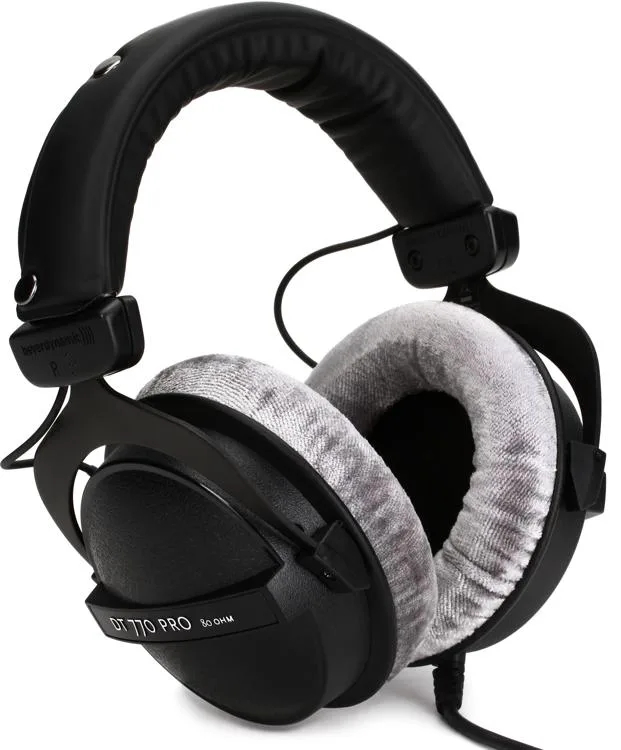
SPECS
- Back Design: Closed
- Frequency Range: 5Hz - 35kHz
- Impedance: 80 ohms
Beyerdynamic's DT 770 Pro headphones are our favorite choice overall as they provide professional-quality sound across a fairly wide spectrum, along with a truly comfortable fit that those putting in long studio hours absolutely need to get things done.
A wide frequency response range of 5Hz - 35kHz and a closed-back design align in these excellent budget studio headphones to minimize outside noise while maximizing the accuracy of any sounds being monitored.
With a durable build and reliable performance, these headphones are a great addition to any studio where wear and tear are often problematic.
Beyerdynamic DT 770 Pro headphones yield extremely accurate sound monitoring at a great price. Plus, they offer a respectable 80-ohm impedance for use with minimal amplification.
These headphones also come with both a gold-plated 1/8 inch TRS plug and a 1/4 inch adapter, making them versatile for a wide variety of audio equipment setups.
The most important benefit of the Beyerdynamic DT 770 headphones is their closed-back ear cup design, as it has been painstakingly equalized to meet diffuse-field EQ requirements.
Diffuse-field equalization gives these headphones a sensationally accurate and balanced sound that mirrors what you would hear in an actual room, making them ideal for serious mixing and mastering.
Want to Learn More About Sennheiser? See the Best Budget Sennheiser Headphones Here
2. Best Budget Studio Headphones – Behringer BH 470 Studio Monitoring Headphones

SPECS
- Back Design: Closed
- Frequency Range: 20Hz - 20kHz
- Impedance: 32 ohms
Behringer BH 470 Studio Monitoring Headphones should be right at the top of the list for those looking to get great cans on a tin-can budget. These headphones offer excellent playback quality and comfortable design at a truly outrageous price of only $25.
Packing 40mm dynamic drivers and a 20Hz - 20kHz frequency response, Behringer's BH 470s are guaranteed to give a high-quality representation of your mix.
The closed-back design effectively blocks out environmental noise, allowing for focused listening and laser-like mixing precision. Comfortable ear cups and a decent headband keep aching ear incidents to a minimum, even during those long, late-night sessions.
These cheap studio headphones have received plenty of praise from users for their exceptional sound quality, durability, and mind-bogglingly low price.
Even after being subjected to rough handling for years on end, the BH 40s tend to stay both functional and comfortable enough to get serious studio work done. If you're just getting started with studio work, then these may be a practical purchase worth making.
3. Best Workhorse Headphones – AKG K240 Studio Semi-open Pro Studio Headphones
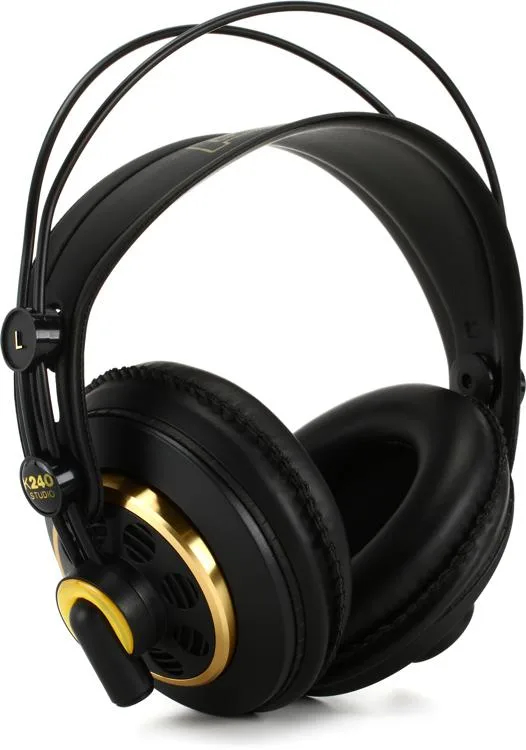
SPECS
- Back Design: Semi-Open
- Frequency Range: 15Hz - 25kHz
- Impedance: 55 ohms
AKG K240 Studio headphones are a reliable, comfortable, and accurate choice for aspiring pros in the music industry who need to make ends meet without compromising on quality.
With their unique semi-open design and efficient transducers, these headphones offer a wide dynamic range, exceptional detail, and high sensitivity - perfect for detecting every single sound in your mixes.
These headphones feature a self-adjusting headband for a perfect fit and a semi-open back design that provides accurate audio reproduction with a bit of built-in isolation.
AKG's K240 cans also come with a 10' replaceable cable and a pair of ear cups that you can simply swap out instead of splurging on all-new headphones a few years down the line.
Users report that these cheap studio headphones are incredibly durable and resilient, surviving various mishaps and rough handling without any major damage. They should stand the test of time in all but the most demanding of recording studios.
Want to Learn More About Headphones? See Our Favorite Affordable Drumming Headphones Here
4. Best for General Use – Audio-Technica ATH-M50x Closed-back Studio Monitoring Headphones
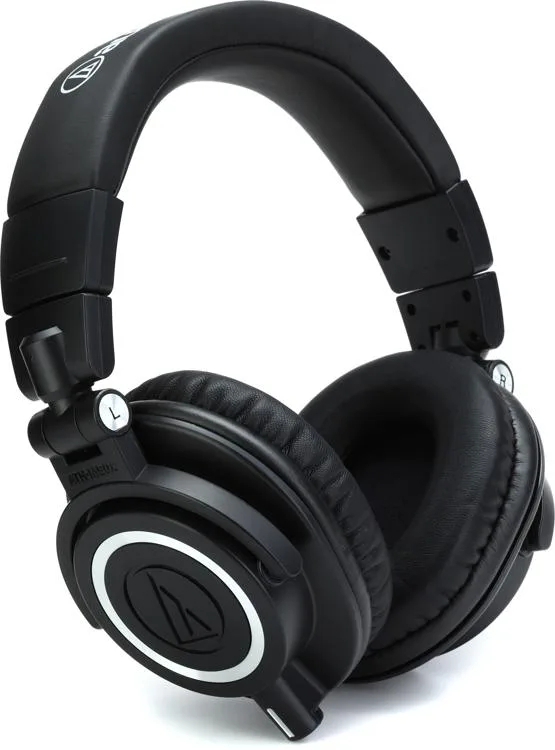
SPECS
- Back Design: Closed
- Frequency Range: 15Hz - 28kHz
- Impedance: 28 ohms
The ATH-M50x Studio Headphones by Audio-Technica are an excellent choice for pros seeking high-fidelity monitor headphones.
These flagship headphones offer critically acclaimed sonic performance and build quality, making them a favorite among top audio engineers and enthusiasts alike.
With a frequency response range of 15Hz to 28kHz and 45mm neodymium magnet drivers with copper-clad aluminum wire voice coils, the ATH-M50x delivers accurate and detailed sound at an attractive price point.
The closed-back design makes for great isolation with minimal sound leakage, while circumaural ear pads ensure you'll be comfortable during long recording and mixing sessions.
These cheap studio headphones feature 90° swiveling ear cups for easy one-ear monitoring, and their collapsible design allows for space-saving portability. The ATH-M50x comes with detachable cables too. You can choose either coiled or straight cables, as both options are included.
People describe these headphones as big, balanced, clear, and capable of handling low frequencies cleanly - a big plus when you're tracking basses or electronic drums.
5. Best for Convenience – Sennheiser HD 280 Pro Closed-Back Studio and Live Monitoring Headphones
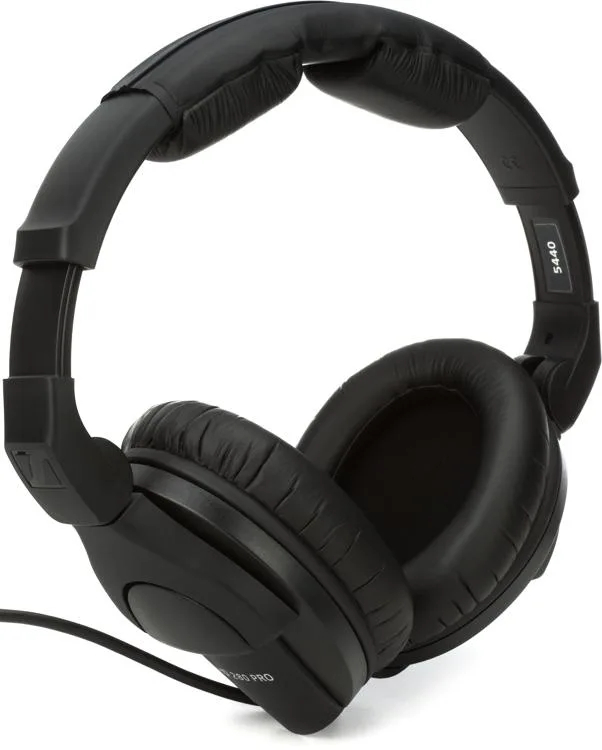
SPECS
- Back Design: Closed
- Frequency Range: 8Hz - 25kHz
- Impedance: 64 ohms
Sennheiser HD 280 Pro headphones offer exceptional comfort alongside 32 decibels of acoustic isolation.
You can count on these to give you a comfortable and immersive listening experience across the spectrum. Their linear frequency response allows for highly accurate and detailed sound reproduction, making them ideal for critical listening and mixing tasks.
Lightweight design, swiveling earpieces, and some pretty neat folding details place these among the most convenient options on this list for both storage and transportation. Completely replaceable ear cups and an included adapter add to the overall versatility on offer here.
Sennheiser HD 280s are highly recommended for studio use as they are extraordinarily consistent, accurate, and affordable. With multiple audio pros using them and vouching for their reliability, these headphones are a great choice to upgrade your own studio without spending too much.
6. Best for Long Sessions – Shure SRH240A Closed-back Headphones
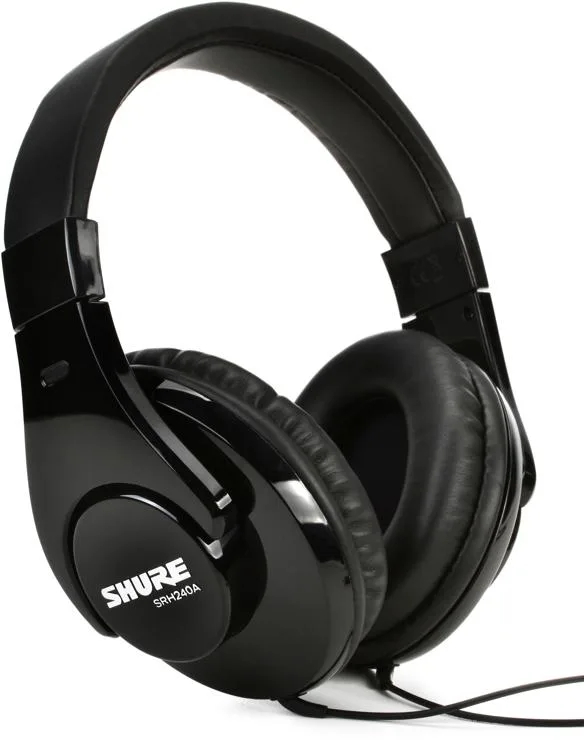
SPECS
- Back Design: Closed
- Frequency Range: 20Hz - 20kHz
- Impedance: 38 ohms
Shure SRH240A headphones are a great choice for anyone looking to put in some serious studio hours.
They offer enhanced comfort, plus a broader range of motion due to a thoughtfully designed headband and ear cup assembly, ensuring a comfortable fit for hours on end.
A closed-back design effectively blocks out external noise, making this ideal for both personal music listening and professional studio recording.
You can count on these cheap studio headphones generating pretty much no headphone mix bleed into live microphones, regardless of the volume you set them at.
Some super solid 40mm neodymium dynamic drivers offer a wide frequency range yielding rich bass and pitch-perfect highs. The SRH240As are optimized for durability and longevity. They also come with a threaded 1/8" - 1/4" adapter for added connection versatility.
These headphones are highly recommended by users for their notably realistic sound, making recorded instruments sound lifelike instead of digital.
7. Best for Natural Sound Quality – Sennheiser HD 599 Open-back Around-ear Audiophile Headphones
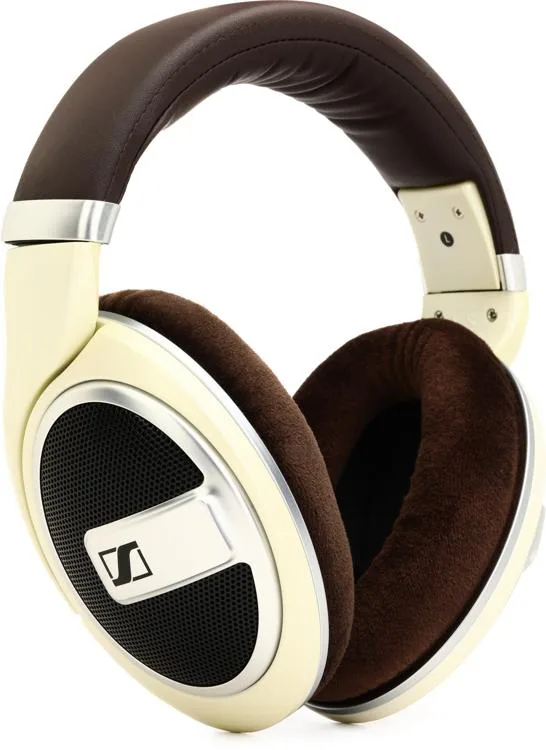
SPECS
- Back Design: Open
- Frequency Range: 12Hz - 38.5kHz
- Impedance: 50 ohms
Sennheiser HD 599 headphones are a great choice on a budget as they offer near-audiophile sound quality with impressive spatial performance.
An open-back design allows for sound to flow freely from the drivers, leveraging Sennheiser's proprietary transducer technology to deliver rich detail and a solid sound stage.
These headphones are also pretty comfortable to wear even after hours of use, thanks to their ergonomic design and replaceable ear pads.
The Sennheiser HD 599 stands out from other brands and models in terms of both sensitivity and volume. Users are claiming they may even surpass some AKG, Yamaha, CAD, and TASCAM headphones too.
These are true audiophile-level headphones for the most discerning of eardrums.
Budget Studio Headphones Buyer's Guide
There's no need to worry when it comes to parsing the detailed spec sheets you see for every pair of studio headphones.
There are actually just a handful of details that are likely to be of any use to you in your search for the perfect pair of cans.
These are back design, isolation, frequency, and impedance.
Back Design
Closed-back headphones prevent sound from escaping, but they can create false low frequencies due to trapped air pressure.
While this design is suitable for most professional and consumer uses, it may not be ideal for certain sources or mixes.
For more accurate frequency balance, open-back headphones are preferred, although they offer slightly less isolation. Well-engineered open-back headphones can provide comparable isolation to high-quality closed-back headphones, but they are usually more expensive.
Alternatively, there are affordable and well-balanced "semi-open-back" headphones like the AKG K240 cans mentioned above that offer sufficient isolation for certain professional tracking scenarios.
Isolation Level
Sound isolation is often a crucial element in mixing and mastering audio. Which is why you should get the best headphones for studio mixing and mastering.
Without enough isolation, external noise can mask a huge portion of your music, undermining quality by quite a bit. No matter how accurate your headphones may be, your biological limitations prevent you from ignoring the noise from your surroundings.
Eliminating outside noise through effective sound isolation is one of the most effective ways to enhance audio quality.
When choosing studio headphones, it is important to prioritize features such as closed-back design and noise cancellation. Closed-back headphones excel at blocking external noise even without resorting to active noise-canceling measures that could degrade the sound quality further.
Frequency Range
The frequency range of your headphones determines the spectrum of audible sound they can reproduce.
While some headphones may have a wider range than the standard 20Hz - 20KHz, it's not necessarily important unless you have exceptionally good hearing.
The range of human hearing typically falls within 20Hz - 20KHz, with few variations throughout the general population. As you age, your ability to hear high-frequency tones decreases, especially if you've been exposed to loud sounds.
Anyone over 25 as well as those with hearing damage, cannot typically hear frequencies above 18,000 Hz at all.
Impedance
Impedance matters when choosing studio cans because it determines the amount of power required for sound production.
This factor is essentially a measurement of the efficiency of transferring audio power into sound waves that you can expect from a given pair of cans.
Headphones have different levels of electrical resistance, known as impedance, ranging from low (8 ohms) to high (600 ohms).
Higher impedance means the headphones use heavier components that are less efficient in converting power into sound. Lower impedance options require less power but may have limitations in spectrum capability.
Most common audio devices have something close to a 16 ohms output, which may struggle to transfer enough power for higher impedance headphones, especially over longer wires.
Frequently Asked Questions (FAQs)
What kind of studio headphones do I need?
When it comes to choosing studio headphones for your control room or mixing suite, you'll want ones that provide the clearest and most accurate sound.
Just like your studio monitors, these headphones should have a frequency response that faithfully recreates the audio signal they receive across all key frequencies.
How do I choose headphones for music production?
When choosing headphones for music production, it's best to go with closed-back headphones. These headphones have a special design that blocks out external sounds, making sure that only your music is heard.
This is important because you don't want any unwanted noises or distractions to interfere with your recording.
Closed-back headphones provide better isolation, so you can focus on your sound without any annoying click tracks or other unwanted sounds getting in the way. It's all about creating a clean and professional final mix. Closed-back headphones help a lot with that.
The buyer's guide above gives a bit more information on what you should be looking for in the perfect pair of studio headphones on a tight budget.
What is the best frequency for studio headphones?
The best frequency for studio headphones is typically in the range of 20 to 20,000 Hz, as that is the standard frequency range that most people can actually hear.
While some of the best budget studio headphones may offer wider ranges, such as 5 to 33,000 Hz, it's important to note that a broader frequency response doesn't necessarily guarantee better sound quality. After all, most of that sound will be inaudible to human ears.
Sticking with the standard range is just fine for most studio listening needs.
Is higher Ohm better for studio headphones?
In simple terms, studio headphones sporting higher Ohms (impedance) can reproduce sound much more accurately, but you need to have the right equipment to power them.
For example, if you plug 100 Ohm headphones into a laptop, you simply won't get the sound quality you would expect because most laptops cannot handle them correctly.
So, while higher impedance can be beneficial, it's important to match the impedance of your headphones with an amplifier that can power them properly to get the best sound.
How do I know if my headphones have good sound quality?
The simplest way to tell if your headphones have good sound quality is by listening to them.
A less obvious answer would be to try playing some acoustic guitar or piano music on them and pay attention to the details. You'll quickly notice the difference between headphones that sound good and those that don't.
Interestingly, two pairs of headphones with different sound characteristics can sometimes have similar specifications. This comes down to distortion and coloring of the audio signal. Some pairs do this intentionally, and they are not really suitable for studio work.
The Takeaway
As long as you have a good idea of what you will actually be using your new headphones to do, it should be easy to decide on the right pair. Use the buyer's guide above to help you along the way, and you'll be mixing music with the best of them in no time.
Stick to closed-back cans if you need to keep sounds isolated and would prefer not to overpower source audio with headphone noise while tracking. The Beyerdynamic DT 770 Pro headphones really are a great choice for most as they offer quality all around, plus a solid back.
For absolute rock-bottom pricing without sacrificing solid studio performance, choose the Behringer BH 470 headphones.
